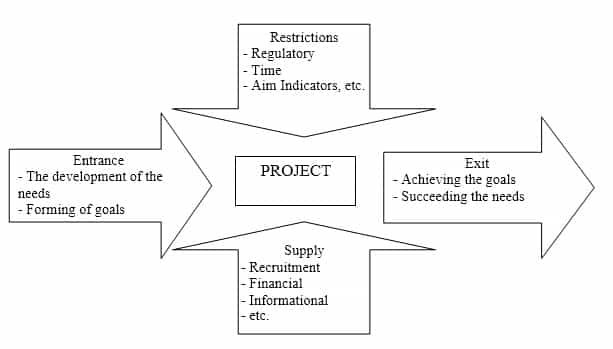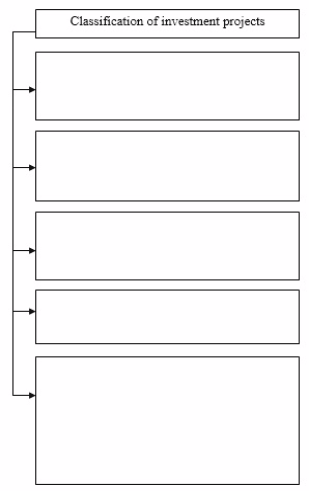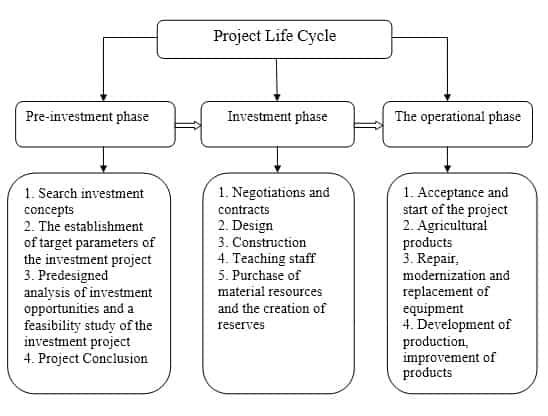Abstract
Content
- Introduction
- The essence and classification of investment projects
- The life cycle of an investment project
- Methods of evaluation of investment projects
- Sources of financing of investment projects
- Conclusions
- List of sources
Introduction
In market economy, investment opportunities are wide, and the company can handle a large number of investment projects.
The investment project is one of the first general investment justification documents and contains aggregated data on proposed nomenclature and volume of production, characteristics of markets and raw material basis, and also contains a number of indicators that give an idea of the commercial, fiscal and economic efficiency of the project in question.
Effective development of the mines can be carried out only in the presence of special scientific basis. Aspects of formation of investment strategy of coal mining enterprises are particularly important in the funding deficit, the lack of which is a feature of the current state of the industry.
The solution of industry production problems is possible on the basis of the reconstruction of the existing promising mines, new mine construction, elimination of unprofitable mines with minor coal reserves simultaneously solving many of the technical, social and environmental issues. However, these areas require billions of investment money, which must be at the same time compared to the standard terms of their return and refund.
As we know, the program of reconstruction and modernization of enterprises provide investment decisions on the project’s reproduction, passive and active parts of the basic means of production. At the same time coal production growth should not limit the scope of the planned production, which is why there is a demand for large investments in new construction and capital reconstruction of mines. The sources of such investments may be own resources of coal mining enterprises, funds of domestic investors, as well as public funds. However, as a result of the global economic crisis, these resources are extremely limited.
At the same time, the problem of finding new investment management techniques in the coal industry remains relevant and requires further development.
1. Analysis of recent research and publications
Research and development of new approaches to the formation of an effective investment strategy for the development of the coal industry in the works performed by such outstanding scientists as A. Akmaev, A. Alimov, A.Amosha, A. Astakhov, I. Buleev, A. Burchakov, A.Vagonova, A. Galushko, V. Geyets, F. Evdokimov, A. Kabanov, V. Kuharev, I. Lukin, V. Neyenburg, I. Petenko, B. Reichel, V. Sally, M. Chumachenko and others.
2. Aims and objectives of the study
The purpose of the master's work is a feasibility of study of the investment project at coal‑mining enterprise by means of involving investments. Achievement of this goal involves the following tasks:
- Expanding the essence of the investment project.
- Considering the investment project lifecycle.
- Considering the methods for evaluating the effectiveness of the project.
- Considering the sources of financing of investment projects.
The object of study – the process of increasing the economic efficiency of coal‑mining enterprise.
Subject of research – attracting investment resources to improve the economic efficiency of coal‑mining enterprise.
1. The essence and classification of investment projects
Y. Popov, O. Yakovenko gives the following definition: the project – it is a company with initially stated objectives, the achievement of which determines the completion of the project. Or the project can be a separate entity with specific goals often include requirements on time, cost and quality of the results achieved [1].
A. Bovin, L. Cherednikova, V. Jakimovich offer to define a project as an activity, event, involving the implementation of a complex of any action to ensure the achievement of certain goals. Or as a system of technical, organizational, legal and financial instruments, needed to implement any action [2].
From the definitions given above, it follows that for all projects the general features are: focusing on the achievement of specific objectives; coordinated execution of interrelated transactions; time and resources limitations; uniqueness (originality).
From a system approach perspective, a project – time limited, organized in a certain way change of a single system, a limited budget and resources of all kinds containing specific requirements to the parameters of the final result. Also, the project can be considered as a transition from the initial to the final state, involves getting measurable results with the participation of certain restrictions and mechanisms (figure 1).

Figure 1 – The project from the perspective of a systematic approach
Definition of aims is the basis of any project. The goal for the project – it is a certain measurable results of the most successful project under specific restrictions and conditions of supply [3].
I. Mazur, V. Shapiro gives the following definition of project management
: the art of leadership and coordination of human and material resources throughout the life cycle of the project by applying the system of modern management methods and techniques to achieve specific project results on the composition and volume of work, cost, time, quality and satisfaction of participants in the project [4].
There is a more expanded definition: Project Management – the application of experience, knowledge, methods and tools for the work of the project to meet the requirements of the project and the expectations of the participants. Meeting these requirements and expectations is necessary to find the optimal combination between the goals, timing, cost, quality and other characteristics of the project [5].
Investment project – a comprehensive action plan aimed at establishing new or reconstruction of existing production of goods and services, to achieve the strategic objectives of the firm, obtain economic or other positive effect.
The investment project refers to a set of documents containing the legitimate aim of the forthcoming activities and specific actions aimed at achieving it. All investment projects can be classified by the following features (figure 2).

Figure 2 – Classification of investment projects
(animation: 6 frames, 6 cicles, 126 kilobytes)
The form and content of investment projects can be very diverse – from the plan of building a new business to the feasibility of buying the immovable property [6].
2. The life cycle of an investment project
Any investment project passes through three stages of development and implementation: pre‑investment, investment and operational constituting in the aggregate of its life cycle (figure 3).

Figure 3 – Project Life Cycle
The first pre‑investment phase includes the following activities: checking the original project plan; drafting tasks for the development and justification of the project; business plan development; choice of location of the object; the allocation of investment in the design; tenders for the design; selection of the project organization and the conclusion of her contract; a feasibility study for the project; the development of design and estimate documentation; approval of design and estimate documentation; allotment of land for construction; obtaining construction permits; tenders for construction; the development of working documentation; finally works contract.
The degree of pre‑investment studies varies from the investor's requirements for funding opportunities with the time allocated for their implementation.
There are three levels of pre‑investment studies: opportunities research; preliminary; assessment of feasibility. Lead sheet PINS is the business plan of the investment project.
СThe cost of the pre‑investment stage of studies in the total amount of capital investment is quite high.
The investment phase of the project consists of the following activities: construction of facilities included in the project; installation of equipment; commissioning; prototype manufacture; reaching its design capacity. During the investment phase of the project formed the assets of enterprises sign contracts for the supply of raw materials, components, produced a set of workers and employees generated a portfolio of orders.
The operational phase of the project significantly affects the efficiency of investment in the project. The more time will be allocated during its upper limit, the greater will be the total income. During this phase, carried out routine monitoring of economic indicators of the project, to the investor could correlate the impact of the project with their expectations [7, 11].
3. Methods of evaluation of investment projects
There are both simple and complex methods of evaluation of the investment project. By the simple methods of evaluation of investment projects include:
1. The definition of payback period – is the period at the end of which the sum of cash gains from the sale of the investment project will be equal to the sum of the initial capital investment in the investment project. Payback time characterizes the time period during which the investor made investments in the project will be refunded the income from its sale.
The payback period can be determined with and without discounting the cash flows. Payback period of discounting is called the length of time from the start time to the moment of payback with discounting.
The moment of payback with discounting is called the earliest point in time in the billing period, after which the current net present value becomes in the future remains a non‑negative;
2. The method of calculating return on invested capital. This method is based on the use of information about the cash flows of the possibility of making a profit from the sale of the investment project. This method has several drawbacks due to the fact that does not include the time component of cash flows does not distinguish between projects with the same sum of the average annual income, but varying the amount of profit for the year, among the projects that have the same average annual profit, but generated for different numbers of years [6, 10].
By the sophisticated methods of evaluating investment projects include:
1. Methods of determining the value of investments using the compound interest – based on reinvestment of the annual interest income. As a result, the investor receives income both originally invested capital, and with the interest earned in previous years. This method is called compounding, i.e., cost reduction, and the results to the end point in time;
2. The method of calculating the net present value of the investment project (net present value, the integral economic effect) – the excess of the integral (for the billing period) discounted cash flows over the integral discounted cash payments arising from the implementation of the investment project;.
3. Determination of the internal rate of return of investment projects – the discount rate to apply to the value of zero net present value. It reflects the amount of profit per unit of investment in the project [7, 10].
4. Sources of financing the investment projects
The source of financing the investment projects are divided into three groups: own funds, borrowed and invited. To own assets include depreciation charges, net income, funds from the sale of surplus assets.
Borrowings – financial resources are obtained by a loan for a specified period and to be returned to the payment of interest. Borrowed funds include bank loans, the budgets of different levels, represented on a return basis, investment leasing, issuance of bonds, loans and other commodities. A feature of borrowed funds is that the fulfillment of the obligations on them does not depend on the business performance.
Invited funds are provided on a regular basis, which can be paid to the owner of the funds of dividend income, but this is not mandatory, even if the company is profitable. Attracted financing sources include: issuance of preferred and common shares, contributions to the authorized capital.
Internal sources of financing. Own sources – the most reliable of all existing sources of investment financing. In the case of their use reduces the risk of bankruptcy. The bulk of equity of finance investment projects are depreciations. The advantage of depreciation, as a source of investment compared to others is that in any financial position this source occurs and remains at the disposal of the enterprise.
External sources of funding. The need for external financing is felt most strongly in the investment phase of the project. Determining the volume of attracted external financial resources most appropriately addressed in the course of the statement of cash flows. The main feature investment needs with a variety of sources to attract them is the size of available funds on each step of the calculation period, it should be a value not negative. Otherwise, the company will experience a shortage of funds for the purchase of equipment, materials, salaries, repayment of financial liabilities, which means non‑viability of the project, the actual bankruptcy [6].
Conclusions
As a result of this work the concept of the investment project has been studied and found that it is a set of documents containing the legitimate aim of the forthcoming activities and specific actions aimed at reaching it. Studied various types, methods of assessment and sources of financing of the investment project.
List of sources
- Попов Ю.И., Яковенко О.В. Управление проектами: учебное пособие. М.: ИНФРА‑М, 2007. 208 с.
- Управление инновациями в организации: учебное пособие по специальности «Менеджмент организации» / Бовин А. А., Чередникова Л.Е., Якимович В.А. 2‑е изд., стер. М.: Издательство «Омега‑Л», 2008. 415 с.
- Заренков В.А. Управление проектами: учеб. пособие. 2‑е изд. М.: Изд‑во АСВ; СПб.: СПб ГАСУ, 2006. 312 с.
- Мазур И.И., Шапиро В.Д. и др. Управление проектами. СПб.: «ДваТрИ», 1993. 443 с.
- Управление проектами в машиностроении: Учебное пособие / Перевощиков Ю. С. и др. М.: ИНФРА‑М, 2010. 233 с.
- Кузнецова, С.А. Инвестиции: учебное пособие/ Кузнецова С.А. – Саратов: Ай Пи Эр Медиа, 2012. – 179 с.
- Колтынюк Б.А. Инвестиции. Учебник. – СПб.: Изд‑во Михайлова В.А., 2003. – 848 с.
- Инвестиционные проекты: Учебник / Под ред. Колтынюка Б.А. – СПб.: Изд‑во Михайлова В.А., 2002. – 622с.
- Ковальчук І.В. Економіка підприємства: Навч. посіб. – К.: Знания, 2008. – 679 с.
- Анопченко Ю.А., Кравченко А.А. Методы оценки эффективности инвестиционного проектирования // Материалы 13-й Международной научной конференции «Современные проблемы и перспективы развития экономики». – Донецк: Издательство Донецкого национального технического университета, 2016. – 157 с.
- Тихонов С.В. Выбор маркетинговой стратегии в зависимости от жизненного цикла предприятия. Актуальные проблемы управления: Сборник научных статей. Электронное издание / ред. кол. – Яшин С.Н., Ширяева Ю.С. – Н.Новгород: ННГУ им. Лобачевского Н.И., 2015. – 363 с.
- Кравченко А.А. Анализ методов определения ставки дисконтирования при оценке эффективности инвестиционных проектов. Сборник материалов II международной научно‑практической конференции 20 апреля 2016 г. – ДонНТУ: Донецк, 2016.
